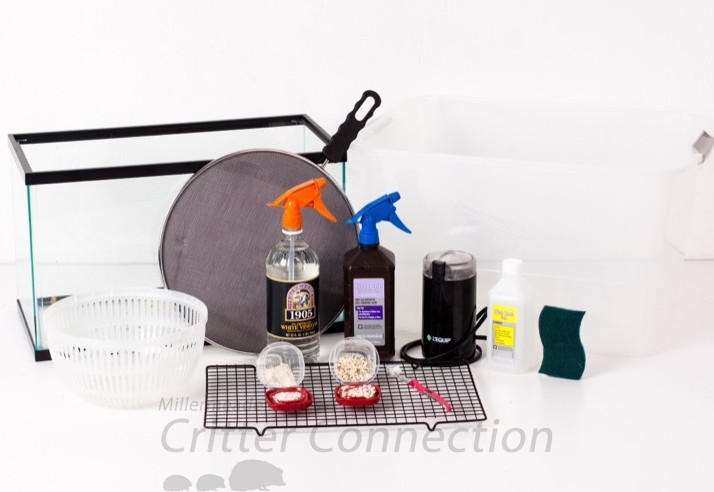Last Updated on October 30, 2022.
Introduction
- A clean cage is essential to the health and well being of your pet.
- Our rule of thumb is that if the cage smells bad to us, it probably smells really bad to our hedgehog. Hedgehogs have a much better sense of smell than we do.
Type of Cage
- The type of cage and the ventilation it provides can make a difference in the level of odor that accumulates in the area of the cage. A glass aquarium or plastic bin with poor ventilation will harbor odor, moisture, and will encourage bacterial growth, which will in turn create an unsanitary living environment for your hedgehog.
- If you should choose to use these types of cages, you may need to perform complete bedding changes more frequently than with a wire-topped cage.
- Solid plastic bottom cages with coated wire tops provide the needed ventilation and they are our recommended choice of cage. Regardless of the type of cage you use, you will still need to perform regular cage cleanings.
Type of Litter
- Different types of bedding have different absorbency levels so the cage may need to be cleaned more or less frequently depending on the size and general messiness of your hedgehog.
- Pelleted beddings may allow you to sift the good bedding from the soiled bedding to be reused after the bottom has been cleaned.
-
- Refer to our Bedding Guide for more information on types of bedding available.
Spot Cleaning
- To help keep the cage clean and smelling fresh, daily spot cleaning of feces, soiled bedding, and uneaten food items is recommended.
- Add fresh bedding as needed.
- If your hedgehog will use a litter pan, this makes daily spot cleaning even easier.
- Simply empty or sift the litter pan, add new litter if needed, and you have a clean fresh cage.
- Depending on the cleanliness of your hedgehog, you will also need to clean and disinfect food dishes, water bottles, wheels, and any other cage toys or accessories.
Weekly Cleaning
- The average hedgehog cage needs to be thoroughly cleaned once a week, but spot cleaning may extend the life of the bedding.
- If you are not cleaning your food bowls and water bottles during the week, you will need to do so at your weekly cage cleaning.
- Wash and disinfect the food bowl and using a bottle brush (available at most pet stores or you may use a baby bottle brush), clean out the bottle, gasket, and sipper tube. Be sure to rinse these items well before using.
- Most cage furnishings should also be thoroughly cleaned once a week.
Complete Bedding Changes
- The average hedgehog cage needs to be thoroughly cleaned once a week.
- A complete bedding change should consist of all the bedding and litter in the cage being discarded.
- The cage will need to be cleaned and disinfected, rinsed properly and dried, before filling with fresh bedding.
Cage Cleaning
- We do not recommend using perfumes or deodorizer additives in the litter or bedding, because they can encourage us to be more lax in cage cleaning.
- Dirty cages and resulting build up of bacteria can cause or increase the risk of respiratory and skin infections.
- It is a good idea to thoroughly wash or soak the plastic bottom when doing a complete bedding change. Plastic can absorb odor and a good disinfectant will help to eliminate lingering odors. (See cleaning products and disinfectants below.)
- Be sure to place your hedgehog in a safe, secure, and warm place while you are cleaning the cage.
- Having a small transport cage, cat carrier, or escape-proof area available, will be helpful during cage cleaning time.
Cleaning Products and Disinfectants
- Almost every cleaning product should be thoroughly rinsed from your cage and cage accessories, before putting your hedgehog back into its cage.
- Nolvasan is a popular cleaning product used by veterinarians and breeders of various kinds of animals. It can be purchased online or through your veterinarian.
- A two-step cleaning process utilizing hydrogen peroxide and white vinegar is reported to kill more bacteria and is much safer than bleach. It is non-toxic and effective at eliminating odors. The hydrogen peroxide must be stored in the original dark container and should not be premixed with the vinegar. Either the hydrogen peroxide or the vinegar can be sprayed or wiped on with a rag and then the other product applied when the first is still wet.
- Pet stores and pet supply catalogs/internet sites also carry enzymatic cleaners made specifically for small animals. There are many different names and brands, but most work on the same principle. As with all cleaners, follow the instructions and be sure to thoroughly rinse with water.
- Critter Fresh – by Virbac, Clean Cage Deodorizer (spray or wipes) – by Pets International, Nature’s Miracle Small Animal Cage Wipes – by Pets N People, ZooMed Wipe Out 1 Terrarium & Small Animal Cage Cleaner are just a few of the cleaners available. Some of the above cleaners are safe enough that they do not need to be rinsed after use.
Contributors: Gail Smith, Shelly Fowler, Beach Bum Hedgehogs, Susan Crocker, Susan’s Hawkeye Hedgies, Melissa Ramos






